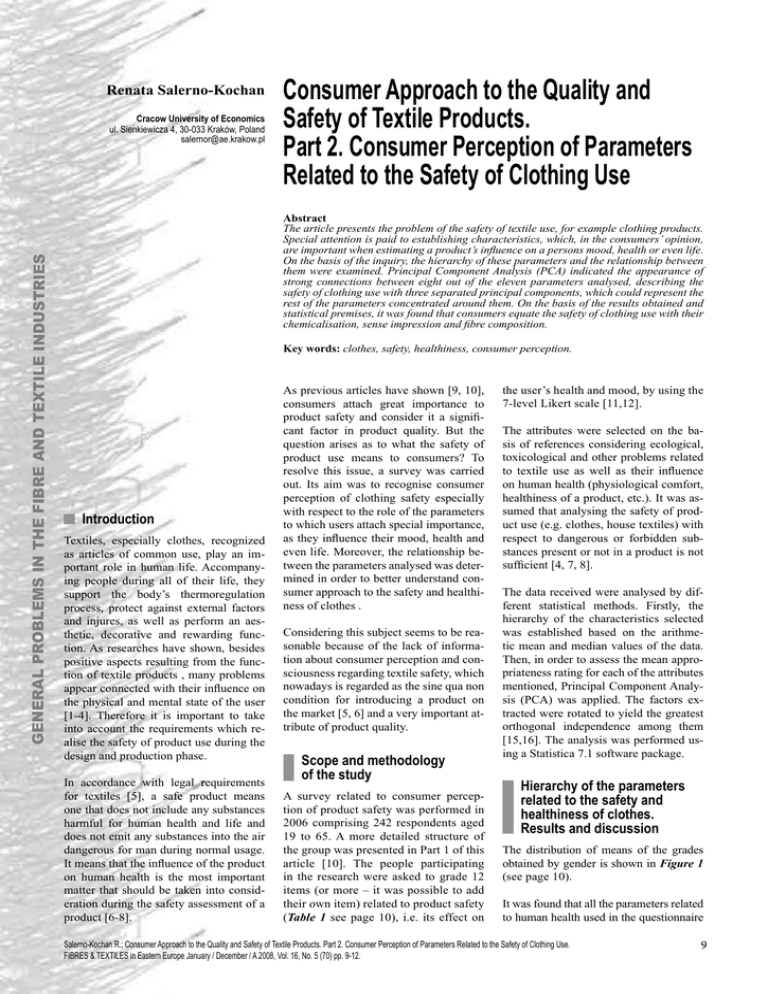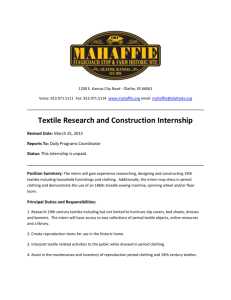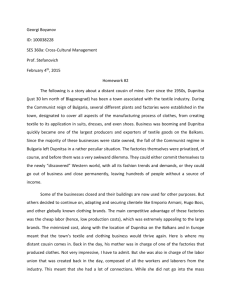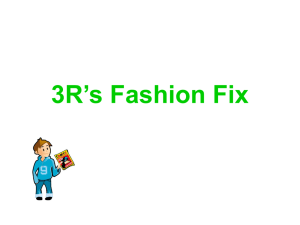Consumer Approach to the Quality and Safety of Textile Products.
advertisement

Renata Salerno-Kochan GENERAL PROBLEMS IN THE FIBRE AND TEXTILE INDUSTRIES Cracow University of Economics ul. Sienkiewicza 4, 30-033 Kraków, Poland salernor@ae.krakow.pl Consumer Approach to the Quality and Safety of Textile Products. Part 2. Consumer Perception of Parameters Related to the Safety of Clothing Use Abstract The article presents the problem of the safety of textile use, for example clothing products. Special attention is paid to establishing characteristics, which, in the consumers’ opinion, are important when estimating a product’s influence on a persons mood, health or even life. On the basis of the inquiry, the hierarchy of these parameters and the relationship between them were examined. Principal Component Analysis (PCA) indicated the appearance of strong connections between eight out of the eleven parameters analysed, describing the safety of clothing use with three separated principal components, which could represent the rest of the parameters concentrated around them. On the basis of the results obtained and statistical premises, it was found that consumers equate the safety of clothing use with their chemicalisation, sense impression and fibre composition. Key words: clothes, safety, healthiness, consumer perception. Introduction Textiles, especially clothes, recognized as articles of common use, play an important role in human life. Accompanying people during all of their life, they support the body’s thermoregulation process, protect against external factors and injures, as well as perform an aesthetic, decorative and rewarding function. As researches have shown, besides positive aspects resulting from the function of textile products , many problems appear connected with their influence on the physical and mental state of the user [1-4]. Therefore it is important to take into account the requirements which realise the safety of product use during the design and production phase. In accordance with legal requirements for textiles [5], a safe product means one that does not include any substances harmful for human health and life and does not emit any substances into the air dangerous for man during normal usage. It means that the influence of the product on human health is the most important matter that should be taken into consideration during the safety assessment of a product [6-8]. As previous articles have shown [9, 10], consumers attach great importance to product safety and consider it a significant factor in product quality. But the question arises as to what the safety of product use means to consumers? To resolve this issue, a survey was carried out. Its aim was to recognise consumer perception of clothing safety especially with respect to the role of the parameters to which users attach special importance, as they influence their mood, health and even life. Moreover, the relationship between the parameters analysed was determined in order to better understand consumer approach to the safety and healthiness of clothes . Considering this subject seems to be reasonable because of the lack of information about consumer perception and consciousness regarding textile safety, which nowadays is regarded as the sine qua non condition for introducing a product on the market [5, 6] and a very important attribute of product quality. Scope and methodology of the study A survey related to consumer perception of product safety was performed in 2006 comprising 242 respondents aged 19 to 65. A more detailed structure of the group was presented in Part 1 of this article [10]. The people participating in the research were asked to grade 12 items (or more – it was possible to add their own item) related to product safety (Table 1 see page 10), i.e. its effect on the user’s health and mood, by using the 7-level Likert scale [11,12]. The attributes were selected on the basis of references considering ecological, toxicological and other problems related to textile use as well as their influence on human health (physiological comfort, healthiness of a product, etc.). It was assumed that analysing the safety of product use (e.g. clothes, house textiles) with respect to dangerous or forbidden substances present or not in a product is not sufficient [4, 7, 8]. The data received were analysed by different statistical methods. Firstly, the hierarchy of the characteristics selected was established based on the arithmetic mean and median values of the data. Then, in order to assess the mean appropriateness rating for each of the attributes mentioned, Principal Component Analysis (PCA) was applied. The factors extracted were rotated to yield the greatest orthogonal independence among them [15,16]. The analysis was performed using a Statistica 7.1 software package. Hierarchy of the parameters related to the safety and healthiness of clothes. Results and discussion The distribution of means of the grades obtained by gender is shown in Figure 1 (see page 10). It was found that all the parameters related to human health used in the questionnaire Salerno-Kochan R.; Consumer Approach to the Quality and Safety of Textile Products. Part 2. Consumer Perception of Parameters Related to the Safety of Clothing Use. FIBRES & TEXTILES in Eastern Europe January / December / A 2008, Vol. 16, No. 5 (70) pp. 9-12. 9 Table 1. Characterisation of items related to product safety and healthiness that were used in the questionnaire. No. Attribute Explanation 1 Presence of harmful substances e.g. formaldehyde, heavy metals, carcinogenic dyes, pesticides – such substances may have an allergenic and skin irritating effect causing rashes, itching, and some of them can cause cancer [e.g. 3, 4, 5, 6, 13] 2 Emission of volatile organic substances from the product to the atmosphere e.g. formaldehyde, toluene – prolonged breathing in of high concentrations can cause headaches, dizziness and syncope [5, 6, 13, 14] 3 pH of the product the pH value should be close to that of the skin to avid irritation, especially in susceptible people [3, 6] 4 Dyeing fastness decomposition of some dyes can produce harmful substances that, having been washed out by sweat or saliva, may penetrate into the body causing internal organ disturbances [3, 6, 13] 5 Physiological comfort important for clothes; is estimated based upon air and water vapour permeability, warmth retention, etc – is responsible for appropriate climate near the skin (temperature, humidity) [e.g. 1, 4, 8, 17]. 6 Static electricity electric charges collected on the product surface may have an adverse effect on the frame of mind as charged clothing can adhere to the body [4]. 7 Aesthetic of the product colouring, design or fashion can have an effect on the user’s mood and frame of mind [8, 18] 8 Sensory sensation (feel, odour) e.g. stiff and rough clothing materials may irritate skin, while soft and delicate ones give comfort and heat sensation; however, the resulting odour can cause an irritating, repulsive, neutral or soothing effect (aromatherapy) [4, 12]. 9 Product construction e.g. a too tight or badly cut product may cause constraint and abrasion (or impede postnatal development), while well-designed ergonomic products create a good mood and and are more convenient [2, 4] 10 Accessory selection and way of fastening, especially for young children e.g. the presence of nickel in metal parts, improperly sewn buttons or lack thereof in children’s clothing (up to 3 years of age) can cause chocking, suffocation etc [2, 19] 11 Kind of fibres some raw materials may cause sensitisation and have an adverse effect on physiological comfort etc, while other materials have an advantageous or even salubrious influence [4, 20, 21]. 12 Combustibility, flame especially important in the case of house textiles; textiles can easily spread fire or emit harmful substances of thermal decomposition into the atmosphere [6, 7, 14] 13 Others an open question, to indicate an important factor from the point of view of a person participating in the poll. are of great importance and were highly appreciated by the respondents, especially women. The arithmetic means for the entire group under investigation ranged between 5.2 ÷ 6.5 on a 7 point scale. These results may highlight the attitude of consumers to the safety and healthiness of products, so all the factors, which in consumers’ opinion could have any influence on their health or frame of mind, they recognized as worthy of attention. When a detailed analysis was performed, it was found that customers (regardless of gender) mainly identify product safety with harmful substances that could be present or volatilise from the product. People, especially women, also attach an important role to physiological comfort and the way of fastening accessories to young children’s clothing, as well as to product construction. The data also indicate the significant effect of the kind of fibre (5.9), dyeing fastness (5.88) and sensory sensation (5.7); these parameters were graded highly primarily by women. The problem of clothing combustibility was considered by the respondents to not have a strong effect on human health (5.18). It should also be added that the majority of Figure. 1. Hierarchy of the parameters related to the safety and healthiness of clothing products according to the mean grades, and gender of the respondents. 10 respondents didn’t grade this parameter at all. This behaviour may explain that consumers perceive combustibility as a feature more related to protective clothes or to house textiles than to clothes of everyday use . Furthermore, among all the items mentioned, the pH, aesthetic and static electricity of a product appeared to have relatively low importance (the mean for all respondents);however, there was a significant disproportion between grades made by females (above 5.5) and males (4.8 – 5.2). The median values enables to analyse the structure of parameters determining the safety and healthy properties of clothing products. In addition to classification according to importance, the characteristics selected can be grouped as presented in Figure 2. Analysis of the medians makes it possible to establish two categories for parameters related to the safety and human healthiness of clothing products for females and three categories for males. The first category – parameters of great importance to product safety determined for both groups under investigation, includes two identical indices, namely the content of harmful, volatile substances and their emission . Within the female population FIBRES & TEXTILES in Eastern Europe January / December / A 2008, Vol. 16, No. 5 (70) this category also includes product construction and the way of fastening accessories to children’s clothes. The second category includes a more differentiated set of indices for both populations under investigation with respect to type and hierarchy of parameter significance, resulting from psychophysical differences between the respondent groups under consideration. This is especially visible for the ”pH” (women probably associate this index with cosmetics, therefore it is graded more highly ) and dyeing fastness, which for males have a minute effect on the user’s safety and health. Analysis of the median values confirmed previous observations related to the hierarchy of parameters obtained, in general, on the basis of the mean values . However, in some cases the results were surprising, for example the position of product combustibility in the second category (important) of features related to the safety of clothing use both in the female and male populations, while this parameter based on arithmetic means was classified as a less important factor the determining of clothing safety. This phenomena is the consequence of a different interpretation of data by statistical indices and highlights large differences between the respondents’ estimations. Taking into account that more than 50% of those inquired estimated product combustibility as an important feature, we can conclude that this parameter is noteworthy . Relationship between parameters related to product safety To identify factors that predominate within individual groups, an attempt was made to investigate relationships between the parameters analysed. PCA analysis allows the formulation of a new set of significant variables for assessing the effect of a clothing product on human health . When using Kaiser criterion and a scree test, the three principal components were assumed based on all data received . Factor loadings for these components were computed to express the saturation degree with the given factor. By assuming that the factor loadings are bigger or close to 0.7, it is possible to explain relationships between the parameters and new factors. It was computed that the principal components selected explain approximately 64% of variable variances (Table 2). STRUCTURE OF PARAMETERS RELATED TO THE SAFETY OF CLOTHES FEMALES presence of harmful substances emission of volatile organic substances accessory selection and way of fastening them to children’s clothes product construction physiological comfort kind of fibre dye fastness sensory sensation aesthetics of the product pH static electricity combustibility MALES THE MOST IMPORTANT FEATURES presence of harmful substances emission of volatile organic substances (x~=7) VERY IMPORTANT FEATURES (x~=6) IMPORTANT FEATURES (x~=5) physiological comfort product construction accessory selection and way of fastening them to children’s clothes kind of fibres sensory sensation aesthetics of the product static electricity combustibility dye fastness pH Figure 2. Hierarchical structure of clothing product parameters related to safety and human health according to the median values for grades made by respondents of different gender. Table 2. Principal Component Analysis (PCA) for parameters related to safety and human healthiness of clothing products. Values of factor loadings. Principal factor 1 Principal factor 2 Principal factor 3 Presence of harmful substances 0,813588 -0,001638 0,220154 Emission of volatile organic substances 0,857377 0,074895 0,198931 pH of product 0,441746 0,242539 0,551750 Dye fastness 0,669617 0,384457 0,161128 Physiological comfort 0,321190 0,324708 0,531974 Static electricity -0,069501 0,423487 0,720576 Aesthetic of the product 0,046012 0,815962 0,064162 Sensory sensation 0,172366 0,852834 0,116059 Product construction 0,230575 0,678972 0,313245 Accessory selection and way of fastening them to children’s clothes 0,549929 0,348737 0,347535 Kind of fibre 0,269681 0,062965 0,735567 Combustibility 0,272555 -0,014814 0,687857 22,36 20,64 20,59 Attribute % of variable variations The principal components selected are represented by the following variables: Principal factor 1, responsible for 22.36 % of variances, correlated with three original parameters related to product manufacturing technology, in particular to process chemicalisation (coloration, printing, finishing). This factor represents such parameters as “the presence of harmful substances” FIBRES & TEXTILES in Eastern Europe January / December / A 2008, Vol. 16, No. 5 (70) in a product (0.81), “the emission of volatile organic substances” (0.857) as well as “dye fastness” (0.67). These variables, especially two of them, are of the utmost importance for evaluating the safety of product use as confirmed not only by the published customer survey, which indicates that the presence or emission of harmful substances belongs to the most impor- 11 tant factors having an effect on human health, but also scientific premises reflected in legal and other regulations [5, 6] related to launching a product on the market. When considering the significance of these variables and its importance to human health, factor 1 is considered as a critical factor that requires analysis, which is necessary for assessing the safety of use of clothing products and may be called the chemicalisation of a product. To investigate this factor, it is necessary to determine the existence of harmful substances, e.g. formaldehyde, heavy metals, allergic or carcinogenic dyes. Principal factor 2, accounting for 20.64% of the variance, represents the three original variables: “sensory sensation” (0.85), related to textile feeling, “aesthetic of the product” (0.82) and “product construction” (0.68). It should be noted that these parameters are most commonly taken into account during the buying of a product and are decisive when choosing a product . However, when considering its role in the assessment of the effect on the user’s health, one can conclude that they are rather of a psychological character, therefore it can be termed as the ‘sense impression factor’. These parameters are undoubtedly subjective and their grading shows individual customer preferences and can be only estimated. It should be considered as a mental factor and estimated by using sensory analysis methods that involve such components as general appearance ( aesthetic of the product, compliance with individual preferences), feel and assumptions regarding the shape and product design. Principal factor 3 explains 20.59% of variances. This focuses on such parameters as the “kinds of fibres” (0.74), “static electricity ” (0.72) and “combustibility” (0.69). Apart from them, the pH and physiological comfort are also highly correlated with this principal factor . One can find that the kinds of fibres decide, to a large extent, other parameters. Thus, it can be used as an indication factor for the principal component selected, which can be named the ‘fibre composition factor’. By analysing, in turn, the role of original variables of this component and its effect on the user’s health and frame of mind, it can be stated that this factor is responsible for the proper functioning of the body in various ambient conditions. 12 This factor structure reveals that consumers conceptualise the safety and healthiness of clothing products with their chemicalisation, sense impression and fibre composition. Conclusions According to the results of the survey, one can conclude that consumers attach great importance to the safety of use and healthiness of clothing products, i.e. to those attributes that describe the impact of clothes on human health. As the research showed, consumer approach to parameters having an effect on the user’s safety, health and frame of mind depends on gender, but in general the most important features determining the safety of using clothing products are harmful substances that could be present or volatilise from the product. Besides this consumers grade parameters related to physiological comfort, construction of the product, accessory selection and the way of fastening them to children’s clothes very highly. The factor analysis carried out identified 3 principal components enabling the evaluation of the safety of clothing products and their impact on human health from the consumers’ point of view. These components include a critical factor called the ‘chemicalisation of a product’, which is necessary for the assessment of product safety, fibre composition – influencing the physical state of the human body, and sense impression – mental factor of subjective significance to the user. References 1. Havenith G., Interaction of Clothing and Thermoregulation, Exogenous Dermatology, 2002, 1, 221-230. 2. Solińska E., Wykin-Orlikowska G., Piestrzeniewicz J., Estimation of Textiles Products Designed for Infants and Small Children in the Aspect of Hazards Occurring During Their Production, Przegląd Włókienniczy, 1999, 9. 3. Piestrzeniewicz J., Stępnik A., Quality and Safety of Textiles in The Aspect of Laboratory Tests, Przegląd Włókienniczy, 2003, 9, 5-8. 4. Textile and the Skin (ed. Elsner P., Hatch K., Wigger-Albertii W.), Karger AG, Basel 2003. 5. Rozporządzenie Rady Ministrów z 6.04. 2004 r. dotyczące bezpieczeństwa i znakowania produktów włókienniczych, Dz. U. Nr 81, poz. 743, 2004. 6. OekoTex Standard 100, http://www. oeko-tex.com/OekoTex100_PUBLIC /index.asp?cls=02 7. Brzeziński S., Problems of Textile Products’ Safety of Usage, Przegląd Włókienniczy, 2001, 2, 22-25. 8. Salerno-Kochan R., An Analysis of Chosen Parameters Determining Healthiness of Clothes Products, Scientific Letters of the University of Economics, Cracov, 2006, 718. 9. Salerno-Kochan R., An Analysis of Requirements for Textile Products in the Aspects of Obligatory Roles and Consumer Expectations, Scientific Letters of the University of Economics, Cracov, 2004, 658. 10. Salerno-Kochan R., Consumers’ Approach to Quality and Safety of Textile Products. Part 1. Quality of Textile Products from Consumers’ Point of View, Fibres &Textiles in Eastern Europe No 4/2008, pp. 8-12. 11. Churchill G. A., Marketing Research. Methodological Fundamentals, (in Polish) ed. PWN, Warszawa 2002. 12. Schulz H.G., Cardello A.V., Winterhalter C., Perception of Fiber and Fabric Uses and the Factors Contributing to Military Clothing Comfort and Satisfaction, Textile Research Journal, 2005, 75(3), 223-232. 13. Brzeziński S., Textile Printing, (in Polish) vol. II in Fundacja Rozwoju Polskiej Kolorystyki, Łódź 2004, 401-420. 14. Rouette M.K., Encyclopedia of Textile Finishing, Springer-Verlag, Berlin, Heidelberg, New York, 2001, 663-667& 906-911. 15. Sagan A., The Examples of Basic Analitical and Graphical Techniques Application, www.statsoft.pl/czytelnia/marketing/ wprowmarketing.html, 16. Sokołowski A., Sagan A., The Examples of Data Analysis Application in Marketing and Public Opinion Research, www. statsoft.pl/czytelnia/marketing/ wprowmarketing.html 17. Parsons K.C., Human thermal environments, Teylor & Francis Ltd, London 1993. 18. Kobiela-Mendrek K., The Role of Aesthetic Criterion in Estimation of Fitness to Use of Textile Products of Common Use, Przegląd Włókienniczy, 2000, 11, 9-12. 19. Children Clothes. Attention to Suffocations,. Magazyn konsumencki – Test, Stiftung Warentest, 2002, 1. 20. Textiles and Human Skin, Facts and Fictions – Description of Situation from Dermatological Point of View, Informacja Expresowa – Włókiennictwo, 1995, 1, 21. Wykin-Orlikowska G., Manduk-Chuchla T., Massalska-Lipińska T., Mielicka E., The Raw Materials and Structure of Knitted Textiles Selection and Physiological Comfort, Przegląd Włókienniczy, 2003, nr 1. Received 16.01.2007 Reviewed 20.04.2007 FIBRES & TEXTILES in Eastern Europe January / December / A 2008, Vol. 16, No. 5 (70)




